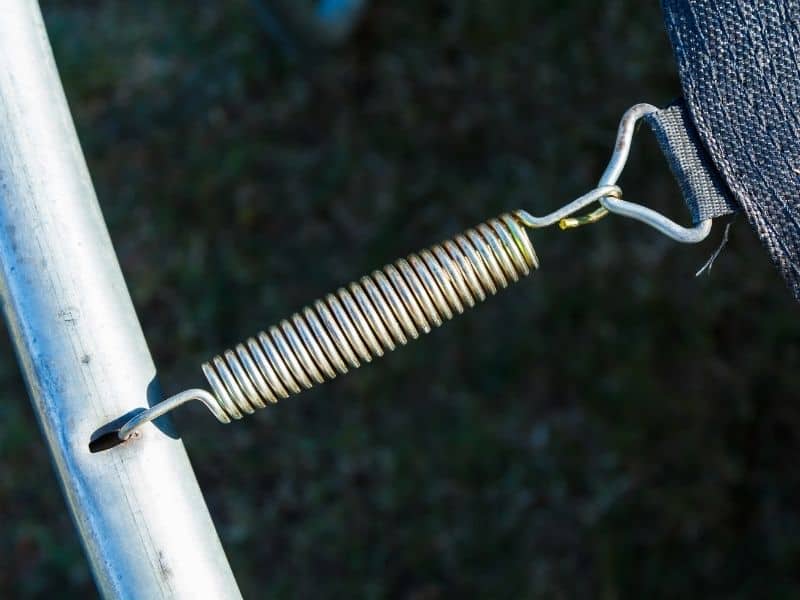If you’ve ever had to put together (or disassemble) a trampoline, you know it’s no easy task.
The whole process can be arduous, but usually, the trickiest part is stretching the mat and connecting the springs to the frame.
Trying to do it by hand, as most people know, requires superhuman strength. That’s why trampolines come with a special tool designed to make the process easier. Without this tool, putting a trampoline together would be virtually impossible.
So, what do you do when it’s time to assemble your trampoline after it’s been in storage – but your spring tool is nowhere to be found?
Fortunately, spring tools aren’t very hard to come by – you can easily purchase one for a few bucks online.
- A must have when putting a trampoline together. Makes…
- Plastic Handle with Finger Grooves,For comfort,…
- The grip is the perfect shape and size, the T-Hook…
- An unsiveral trampoline spring pull tool, support all…
But if you want to save some money or you just don’t want to wait for a new tool to arrive, there are a few ways to get the job done with things you might have lying around the house.
In this article, I’ll outline 7 simple trampoline spring tool alternatives that can make trampoline assembly a breeze!
How To Use a Trampoline Spring Tool
Before we get into the alternative methods, here’s a brief description of spring tools and how they’re used for the uninitiated. Hopefully, this will provide a little context and comparison.
Most trampoline springs have a semi-closed loop on one end and an open hook on the other. The loop end hooks to the V-ring on the mat, while the open end hooks inside a small hole in the frame.
A trampoline spring tool (often called a T-hook or spring puller) is a T-shaped instrument with a small blunt hook on one end and a handle on the other.
To use it, you simply hook the spring to the V-ring, snag the dangling end of the spring with the T-hook, and pull (while bracing against the frame) the spring hook to the corresponding hole in the frame.
Once you’ve guided the hook to the hole, press down on the spring with your free hand to seat the hook in the hole.
Now, let’s look at how we can accomplish this using our alternative methods.
A Note On Safety: When using any of these methods (or even a regular spring tool), it’s always best to use protective equipment – namely, thick gloves and eye protection. This will help you avoid pinches, cuts, and much more serious injuries.
1. Screwdriver/Nut Driver
For this method, all you need is a sturdy screwdriver or nut driver – the key thing is that it has a strong metal shaft small enough to fit through the loop end of the spring and a handle/hilt to prevent the loop from sliding up and hitting your hand.
Here’s how it works:
- Hook the open end of the spring into the frame.
- Insert the shaft of your screwdriver into the loop on the other end of the spring.
- Holding the corresponding V-ring with your free hand, bring the screwdriver toward the mat and insert the tip into the V-ring.
- Moving your free hand out of the way, pivot the screwdriver forward like a lever, and watch as the loop slides down the screwdriver shaft and hooks onto the V-ring.
2. Rope
With this method, all you need is a length of fairly thin but strong rope. It will go a lot faster and easier with two people, but it can be done with only one.
This method may not work with some types of springs, depending on the shape/curvature of the mat hook.
- Tie a long, loose loop in the rope (2-3 feet long if stretched taut) or simply double it up to make a closed end.
- Hook one end of the spring into the frame.
- Pull the closed end of the rope up through the bottom of the V-ring and hook it to the dangling end of the spring.
- Lastly, pull the rope back down through the V-ring until the spring hooks to the V-ring.
Keep in mind when using this method that if the rope snaps or slips off the hook, the spring can recoil back and potentially injure the person standing beside the frame (or anyone else nearby) – so be careful and use protective equipment.
3. Rope & Crowbar
For this method, you’ll need a few feet of sturdy rope thin enough to put through your V-rings and a crowbar or other durable rod or cylinder around 1 foot long – a pipe or a large screwdriver may do the trick.
Here’s how to do it.
- Thread one end of the rope up through a V-ring, bring it back toward you over the frame, and tie it loosely to the slack to form a loop between the frame and the V-ring.
- Insert your crowbar or cylinder into the end of the loop on the outside of the frame so that the rope is in the middle of the cylinder.
- Twist the crowbar repeatedly to make the rope twist up and tighten the loop, pulling the V-ring toward the frame.
- Once the V-ring is close enough, hook the spring onto both the frame and V-ring, then twist the crowbar in the opposite direction to loosen the loop and let the spring pull tight.
This method may be a little time-consuming, but it’s fairly easy and works like a charm.
4. Caulk Gun
This may be my favorite method for its sheer inventiveness. All it takes is a sturdy mechanical caulk gun (preferably made of metal) with a ladder hook on the rear end of the plunger arm – just make sure it’s empty if you want to avoid a big mess.
- PRECISION CAULKING WITH DRIP-FREE TECHNOLOGY: The…
- EXTRA TOOLS INCLUDED FOR VERSATILITY: The Octogun…
- HEX ROD FOR EFFORTLESS CAULKING: The Octogun caulking…
- COMPATIBLE WITH STANDARD 1/10 GALLON CARTRIDGES:…
Here’s how to use this trampoline spring tool alternative:
- Hook the end of the plunger arm to the V-ring and bring the caulk gun parallel to the ground, pointed straight out.
- Press the trigger to crank the plunger forward until the back of the gun handle is braced against the outer edge of the frame, then continue to pump to bring the V-ring closer to the frame.
- When the gap is narrow enough, hook the spring to the frame and the V-ring.
- Press the trigger release to loosen the plunger arm, allowing the spring to stretch taut.
5. Another Trampoline Spring
This is perhaps the simplest alternative to a spring tool and certainly one of the easiest to implement.
You simply use one of your springs the way you would your spring tool:
- Hook one end of the spring to the V-ring.
- Snag the dangling end of the spring with either end of your “tool” spring (preferably the more open end).
- Use the “tool” spring to pull the connector spring toward the frame, simultaneously pulling on the connector spring with your free hand if necessary, until you can hook the spring to the frame.
Of course, unless you have spare springs, you’ll have to use one of the other methods to get the final spring on (if you can’t get it by brute strength alone).
This method also works well for disassembling your trampoline without damaging the springs – simply perform the process in reverse.
6. Pliers
Many people like to use pliers in place of a spring tool. This involves hooking a spring to either the frame or V-ring then gripping the other end with pliers and pulling it until you can bridge the gap and hook it.
While it may work, this method isn’t exactly easy – you’ll still need to muscle the hook to where it needs to be.
It’s also not uncommon for people to hurt themselves attempting this when the pliers slip. The pliers may also mar, gouge, or bend the spring in some cases – so use this method with care.
7. DIY Trampoline Spring Tool
Another option is to just make your own spring tool.
All you need to do this is a piece of wood about 4 inches long and 1-2 inches thick (copper or steel tubing may also work), a long steel nail (5-6 inches), an electric drill, and two pairs of pliers.
Here’s how to do it:
- Drill a hole through the width of the wood piece, directly in the center. The hole should be just wide enough that the nail will fit snugly inside without splitting the wood.
- Gently drive the nail through the hole.
- Use one pair of pliers to grip the nail about ½-1 inches away from the tip. Using the other pair, bend the tip until it forms a hook shape or an angle slightly less than 90 degrees.
Conclusion
So there you have it! There are a ton of creative trampoline hacks out there, some of which serve different purposes.
I hope you found this article helpful. Thanks for reading!



